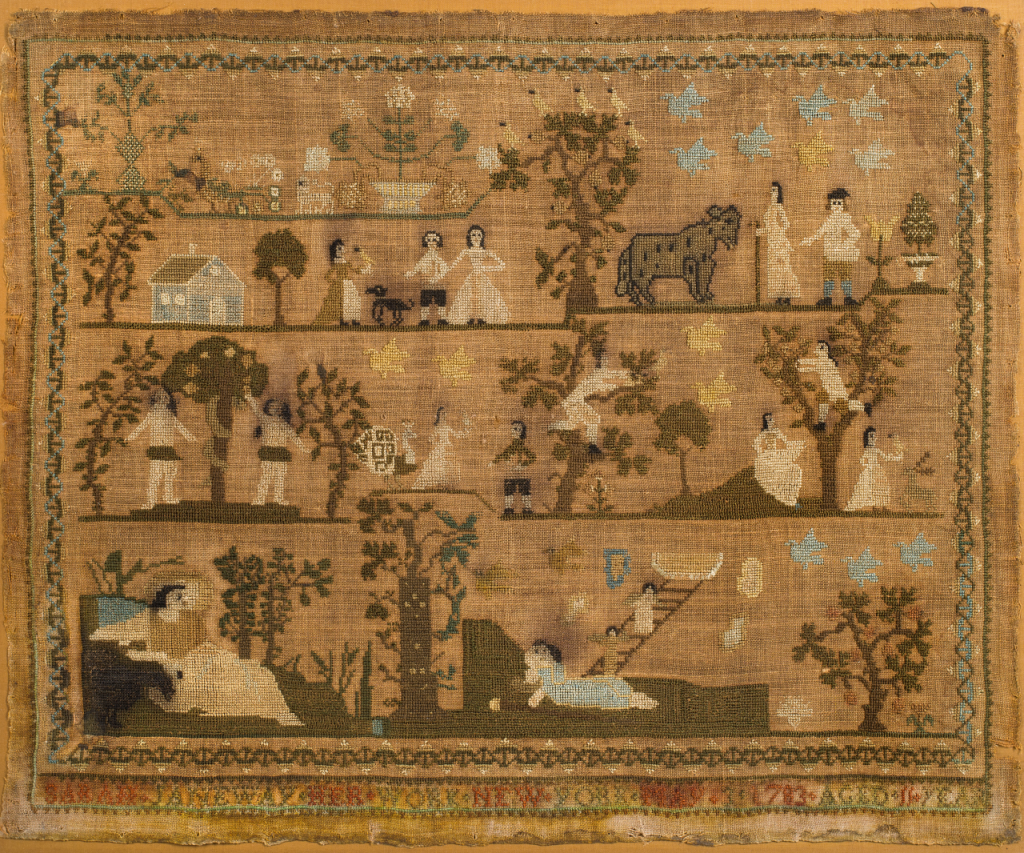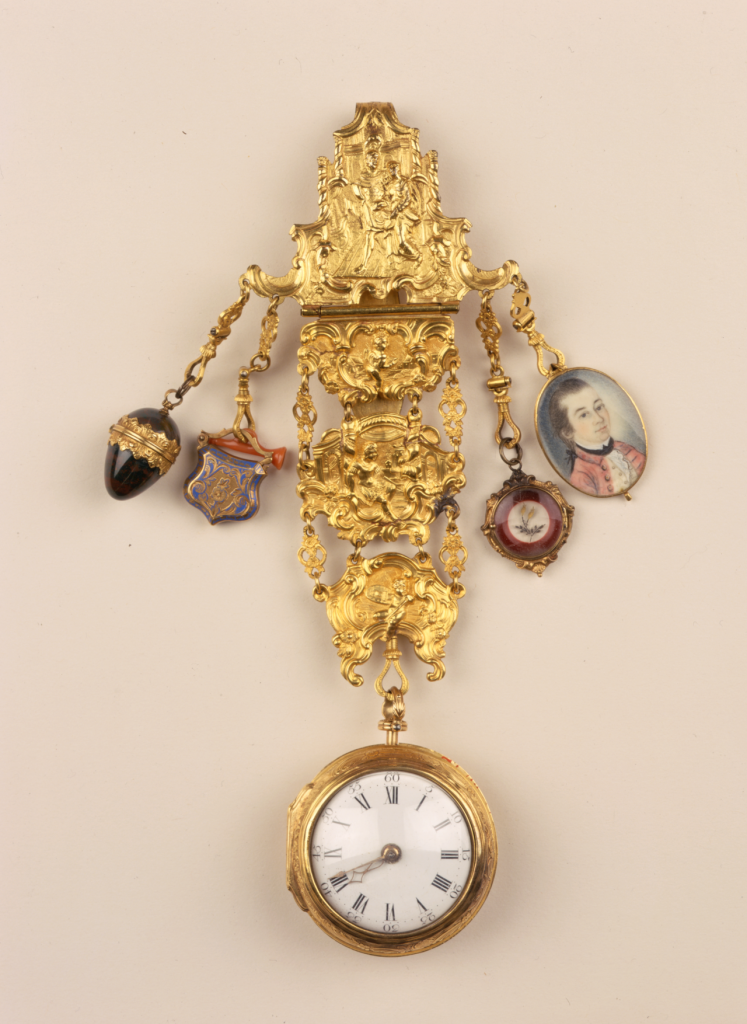Background
The lives of women in the English colonies were hampered by legal and social customs that governed appropriate female work and behavior. Women were considered subordinate to men in all aspects of life, and were expected to prioritize caring for their homes and families. Preparing and cooking food, spinning, weaving, sewing, housekeeping, gardening, and childcare were all the responsibility of women. In the colonial era, this work was difficult, draining, and never-ending. Even the colony’s wealthiest women were not exempt from these expectations, but they did have hired or enslaved women to assist them in their tasks. And any woman who had to work outside the home to support her family had to do that work in addition to her household responsibilities.
About the Artifacts
Training for the life of a wealthy housewife started in early childhood, when young girls were taught to read, keep household accounts, and sew. Young women produced samplers that showcased their superior needlework skills. These works of art could be shown to friends, family, and potential husbands as examples of the young woman’s accomplishments and evidence of her domestic capabilities.
Samplers also revealed the character of the girls who made them. For example, this sampler was made by 11-year-old Sarah Ann Janeway. It includes religious scenes like Adam and Eve at the Tree of Knowledge, Jacob’s Ladder, and Saint John receiving the Book of Revelations. It also has everyday objects like flower-filled urns, a peacock, a small family with a dog, and a single building that represents a house or school. Together, these images demonstrate her spirituality and feminine sensibilities. (Click here to see a portrait of Sarah Janeway made later in her life.)
Once women married, they assumed the status of mistress of their household. Many wealthy married women owned or wore chatelaines, like the one pictured here, as symbols of their domesticity and social status. Chatelaines were clips with hooks or chains that held keys and other small household items. They were symbols of power for women because they were originally used to carry the keys to all the important items in a home, such as the pantry, linen closet, and tea chest. Chatelaines were attached to a belt at the waist so the items they carried were always at hand. During the early eighteenth century, elite women often secured small household implements, such as sewing scissors, thimbles, notebooks enclosed in metal cases, and watches, to their chatelaines. This chatelaine was given to Cornelia Dickenson Remsen by her husband, Henry Remsen, as a wedding gift in 1761.
Together, these items illustrate the optimal path for a young, wealthy colonial girl: from a well-bred and well-trained daughter to the mistress of her own home and family.
Vocabulary
- Adam and Eve: The first man and woman in Judeo-Christian teachings.
- Book of Revelations: The final book of the Christian Bible, which describes what will happen at the end of the world.
- chatelaine: A clip worn at the belt from which keys and small household items could be hung.
- Jacob’s Ladder: A story from Judeo-Christian faith.
- sampler: A work of art made from thread and fabric. Samplers were made to showcase a girl’s or woman’s needlework skills.
Pronunciation
- chatelaines: SHA-tuh-lane
Discussion Questions
- What would it be like to make a sampler as ornate as Sarah Janeway’s?
- Why did wealthy girls need to learn to sew if they had hired and enslaved women to do it for them?
- Why were chatelaines symbols of status and domesticity?
- What do these objects tell us about the women who made and owned them?
- What do these objects reveal about the societal expectations of wealthy colonial girls and women?
Suggested Activities
- Use these objects in any lesson about daily life in the English colonies.
- Combine this image with the portraits of the Rapalje Children and Henrietta Johnston to illustrate what English colonial girls and women looked like.
- Give students needle, embroidery floss, and fabric so they can experience how challenging this art form is.
- Read The Last Will and Testament of Joseph Grover and Coverture to learn more about the legal and social limitations on women in the English colonies.
- Sarah Janeway’s father was a militia captain for the Patriots in the American Revolution. After introducing Sarah through her sampler, ask students to reflect on how she might have been affected by and responded to the events of the American Revolution.
- Women often hung small objects off their chatelaines to symbolize the work they did. Ask students to consider: If women wore chatelaines today, what objects might they hang from them?
- Teach these objects together with the excerpts from the Ornaments of the Daughters of Zion and Milcah Martha Moore’s textbook to expand your student’s understanding what was expected of colonial women.
- These objects are symbols of a very privileged kind of colonial girl- and womanhood. Combine these objects with any of the following resources for a lesson that better represents the diversity of experiences of women in the English colonies: The Mourning Poetry of Anne Bradstreet, Children at Work, Spinning Wheels, Spinning Bees, Life Story: Dennis and Hannah Holland, Ornaments of the Daughters of Zion, Life Story: Deborah Squash, Runaway Slaves, Education in New France, A Woman of Business, Legislating Reproduction and Racial Difference, Life Story: Thomas(ine) Hall, Life Story: Weetamoo, and Childcare in the New World.
- Combine this image with any of the following resources for a larger lesson about childhood in the American colonies: Malitzen of New Spain, Kateri Tekakwitha of New France, The Mourning Poetry of Anne Bradstreet, Life Story: Lisbeth Anthonijsen, Life on the Encomienda, The Middle Passage, Children at Work, The Business of Slavery, Education in New France, Life Story: Dennis and Hannah Holland, Life Story: Mother Esther Marie-Joseph Wheelwright de l’Enfant, The Rapalje Children, The Casket Girls, and Eighteenth-Century Education.
Themes
DOMESTICITY AND FAMILY
New-York Historical Society Curriculum Library Connections
- For more resources relating to childhood in the English colonies, see New World—New Netherland—New York.








